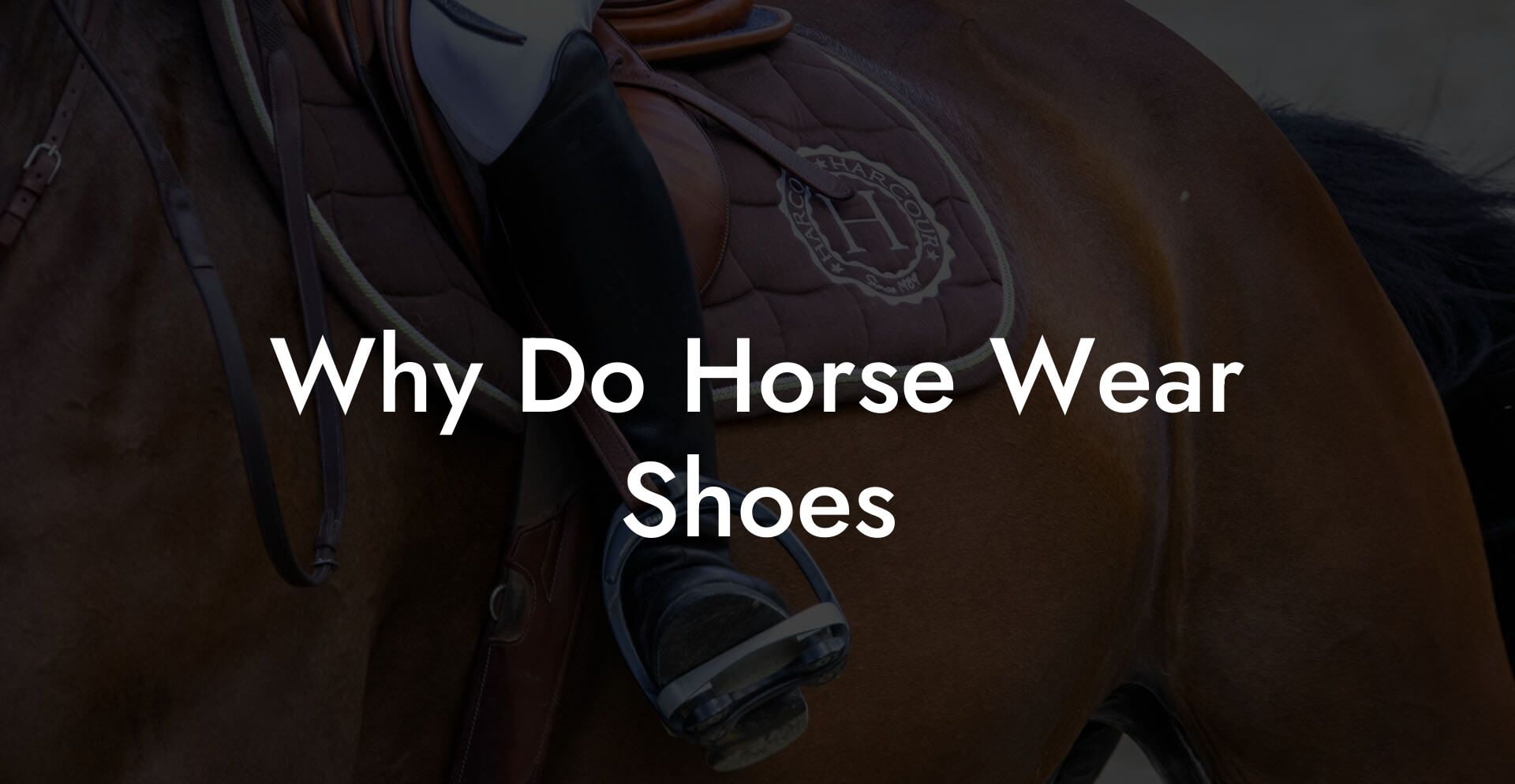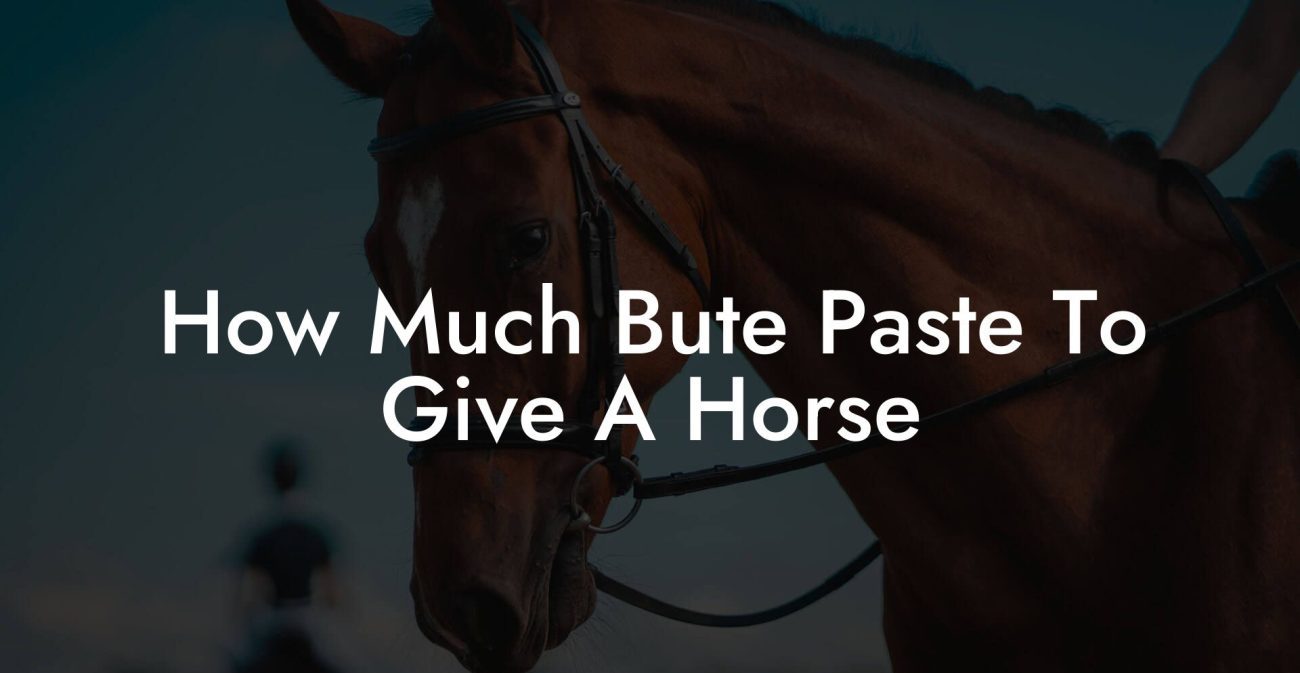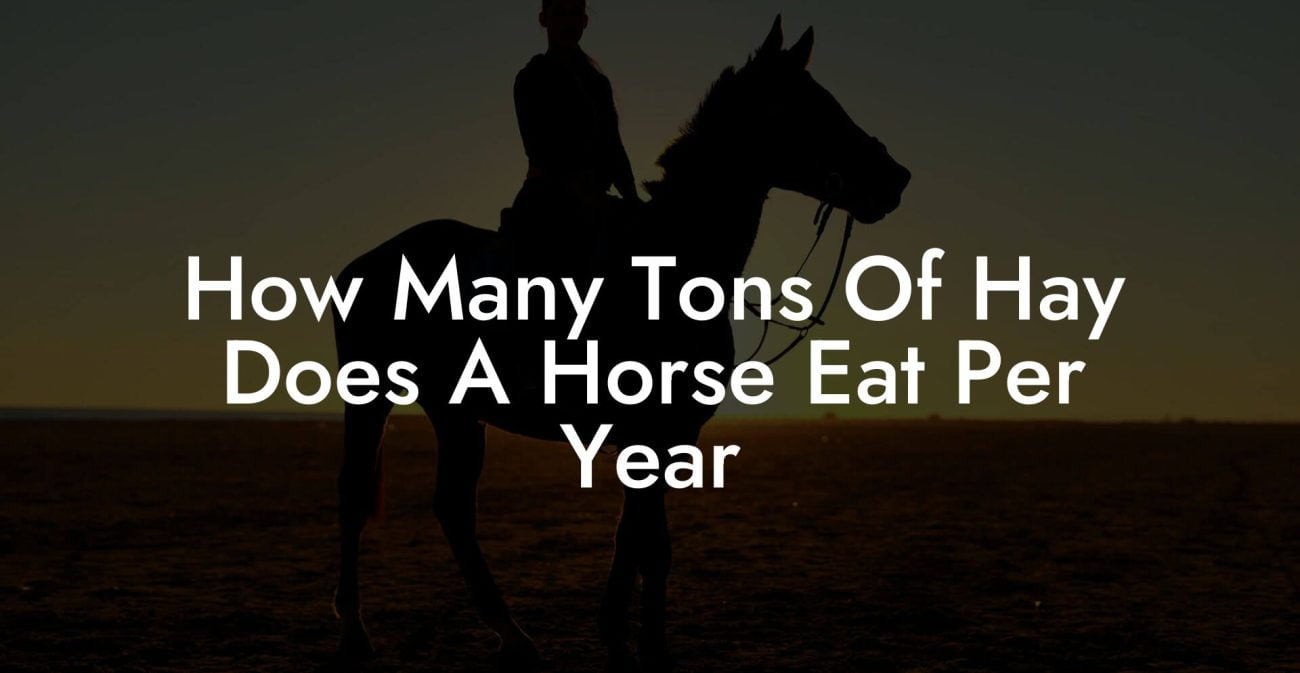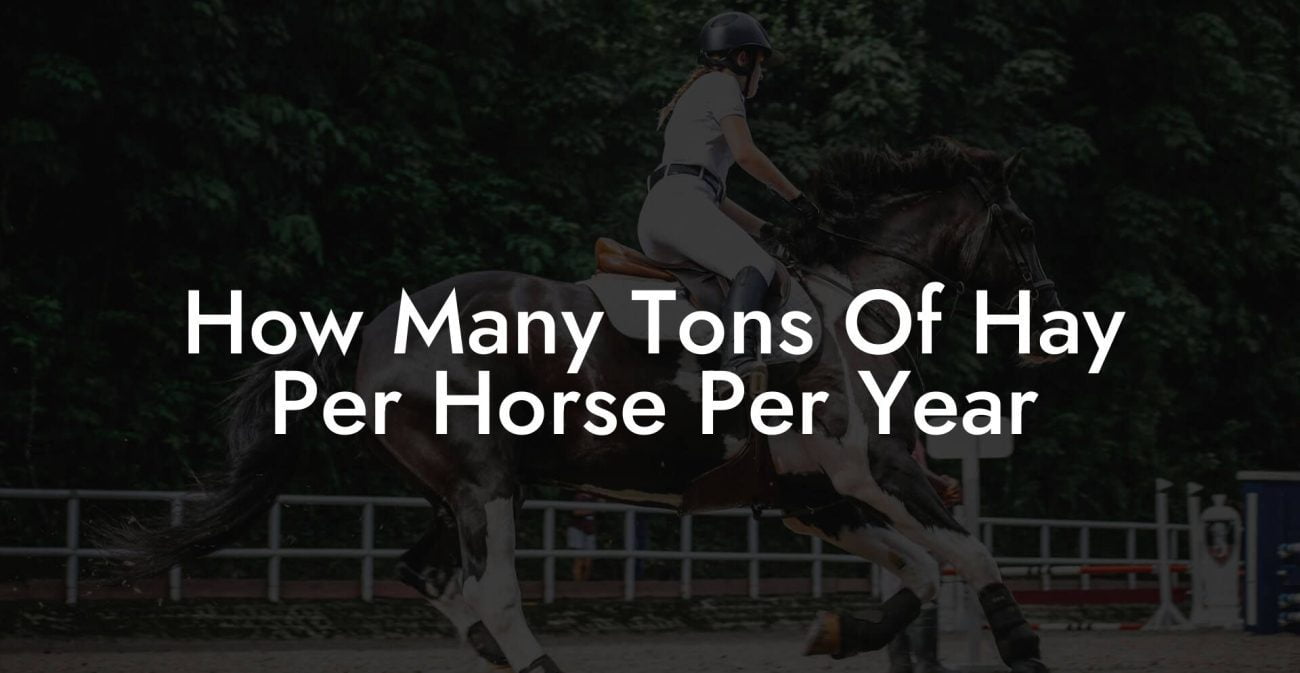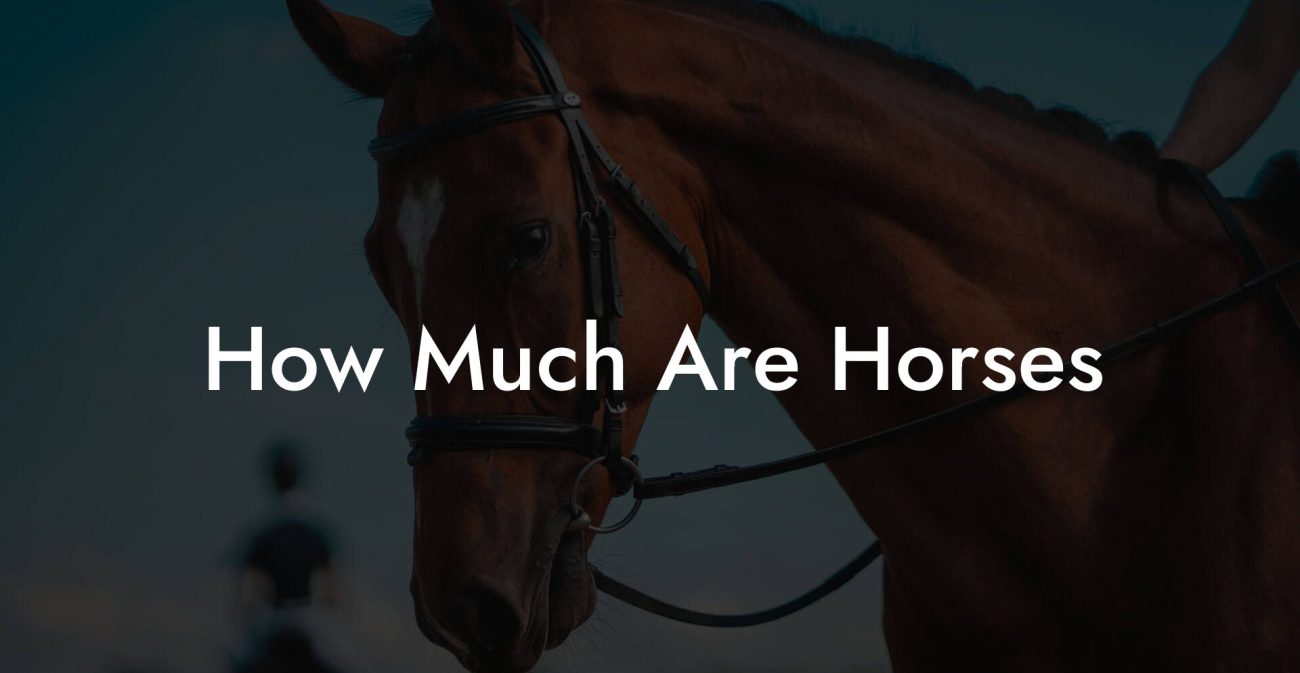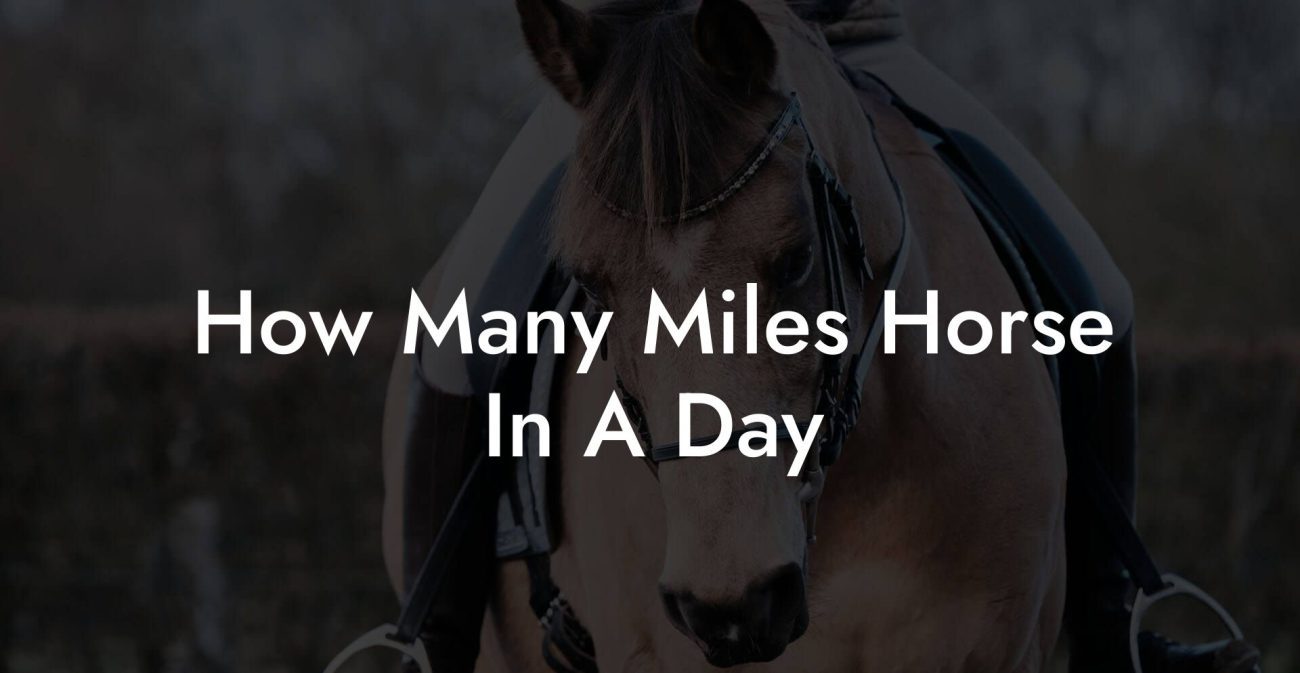Ever wondered why these majestic creatures sport what looks like stylish sneakers on their feet? Horseshoes have been around for centuries, merging tradition with modern-day equine performance. Whether you're a budding equestrian enthusiast or just curious about hooved horse care, this in-depth guide on "Why Do Horse Wear Shoes" is your ultimate backstage pass into the world of equine hoof care, farrier artistry, and innovative alternatives. Get ready to gallop through history, science, and practical horse care tips—all with a dash of humor and plenty of Gen-Z flair.
Quick Links to Useful Sections
- The Legacy and Evolution of Horseshoes
- The Biomechanics Behind the Hoof: A Natural Masterpiece
- Purpose and Performance: Why Do Horses Wear Shoes?
- Farrier Magic: The Art and Science of Horseshoeing
- Debunking the Myths: Do All Horses Really Need Shoes?
- Modern Innovations and Alternatives to Traditional Horseshoes
- Hoof Boots: The Temporary Shoe Solution
- Advanced Materials in Horseshoeing
- Caring for Your Horse’s Hooves: Tips for the Modern Equestrian
- Regular Inspections
- Keep It Clean
- Appropriate Sheltering and Flooring
- Hydration and nutrition for Hoof Health
- Equine Performance and Safety: When Every Step Counts
- Understanding the Farrier-Horse Relationship: Trust, Tradition, and Innovation
- Resources and Community Support: Your Next Steps
- Real-Life Success Stories: Transforming Equine Hoof Care
- Case Study 1: From Slippery Slopes to Sure-Footed Triumph
- Case Study 2: The Barefoot Debate—When Going Natural Works Wonders
- Case Study 3: Racing Ahead—Enhancing Performance Through Precision Shoeing
- Designing Your Personalized Equine Hoof Care Plan
- Step 1: Comprehensive Hoof Evaluation
- Step 2: Set Clear Goals
- Step 3: Select Appropriate Interventions
- Step 4: Implement a Routine Schedule
- Step 5: Monitor, Adjust, and Evolve
- Equine Hoof Health: A Holistic Approach for the Modern Rider
- Equine Hoof Care FAQs: Your Top Questions Answered
- Your Next Step in Equine Care: Gallop Towards Excellence
The Legacy and Evolution of Horseshoes
Our story begins in ancient times when horses, the original four-legged workhorses, helped humans conquer vast terrains. Early riders quickly discovered that the natural wear and tear of rocky landscapes could lead to painful hoof damage. Enter the first primitive horseshoes—a brilliant solution conceived to protect a horse's feet and prolong their stamina.
Over the centuries, these rudimentary pieces of metal evolved into the expertly crafted shoes we see today. From medieval knights racing across battlefields to modern-day equestrians competing on sleek tracks, horseshoes have continuously adapted to meet the challenges of movement, safety, and performance. This evolution speaks volumes about human ingenuity and the deep bond between man and horse.
In essence, horseshoes aren’t just about protection—they symbolize a long history of innovation and dedication to maintaining the health and performance of our equine partners. Today, these metal masterpieces are a blend of artistry and technology, ensuring that horses can thrive in any environment.
The Biomechanics Behind the Hoof: A Natural Masterpiece
At first glance, a horse’s hoof might seem like a simple, blunt structure, but its complexity rivals some of the most advanced engineering. The equine hoof acts as both shock absorber and spring, providing the necessary support and flexibility for every gallop, canter, and trot. Understanding why horses wear shoes starts with appreciating the biomechanics of this natural marvel.
The hoof is comprised of several components: the wall, sole, frog, and bars. Each plays a unique role in dispersing weight, absorbing impact, and ensuring traction on varied surfaces. When a horse trots on a hard, abrasive surface for extended periods, wear and tear can occur, compromising their natural shock-absorbing ability. In comes the horseshoe—designed to mitigate damage while supporting the overall structure of the hoof.
Modern innovation has led to the creation of horseshoes that are not one-size-fits-all. Today’s farriers tailor shoe designs to the specific needs of each horse—whether it’s to improve traction on slippery turf or to correct a biomechanical imbalance. The integration of advanced materials like aluminum alloys, plastics, and even composite materials have revolutionized equine hoof care, making horseshoes both lightweight and resilient.
Purpose and Performance: Why Do Horses Wear Shoes?
You might think horses wear shoes just to look snazzy, but there’s a deeper purpose. Shoes play a critical role in ensuring the horse’s comfort, performance, and overall hoof health. Let’s break down the top reasons:
- Protection Against Wear and Tear: Horses work on a variety of terrains. Shoes help prevent excessive wear on hoof structures, especially on rough or rocky ground.
- Traction and Grip: For horses in competitive sports or challenging climates, shoes can provide better grip on slippery or uneven surfaces, reducing the risk of slips and falls.
- Cushioning and Shock Absorption: The horseshoe works in tandem with the natural hoof to absorb the shock of impact, protecting joints and muscles from stress.
- Corrective and Therapeutic Purposes: Farriers can modify horseshoes to address specific biomechanical issues, correcting imbalances or aiding in the recovery from injuries.
- Performance Enhancement: For horses in racing or dressage, specialized shoes can enhance performance by improving balance and maneuverability.
In a nutshell, horseshoes are the unsung heroes of equine performance. They protect, correct, and enhance natural abilities—much like the perfect pair of sneakers that elevate your game, whether you're skating, jogging, or just chilling at the park.
Farrier Magic: The Art and Science of Horseshoeing
The process of horseshoeing is a blend of art, science, and a healthy sprinkle of old-school craftsmanship. Farriers are the equine equivalent of a master cobbler and orthopedic specialist rolled into one. Their expertise ensures that every shoe fits perfectly, offers optimal support, and accommodates the unique shape of each hoof.
Assessment and Trimming: It all starts with a close inspection of the hoof. The farrier trims the hooves to remove excess growth and maintain proper shape. This step is crucial for ensuring that the hoof functions as efficiently as possible.
Shoe Selection and Fitting: Next, the farrier selects the appropriate shoe for the horse’s activity. Whether the horse is a leisurely trail cruiser or a high-speed racer, there’s a shoe that caters to its specific needs. The shoe is then meticulously molded to the hoof, ensuring a snug fit that won’t hinder natural movement.
Attachment Techniques: Once the shoe fits perfectly, it is attached to the hoof using nails. While the idea might sound a bit harsh for our equine friends, this process is designed to be as gentle and precisely controlled as possible—minimizing discomfort while maximizing durability.
The art of shoemaking is continuously evolving with scientific advances. New materials, better design principles, and improved techniques have made horseshoeing safer, more efficient, and more comfortable than ever. It's where tradition meets high-tech innovation, all for the love of the horse.
Debunking the Myths: Do All Horses Really Need Shoes?
One of the most persistent questions in equine circles is whether horses truly need shoes. The simple answer? It depends on the horse, its activity level, and its environment. There’s a growing movement toward barefoot horses, championed by advocates of natural hoof care and equine wellness.
Barefoot horses, when maintained properly, can enjoy many of the benefits that shoes once provided—such as natural shock absorption and better sensory feedback from the ground. However, for horses that regularly tackle hard or slippery surfaces, or those with certain hoof conditions, shoes remain an essential part of their care.
The decision should always be tailored to the individual horse. With the right balance by a skilled farrier and veterinarian guidance, some horses thrive without shoes, while others prosper with custom-fitted footwear. The emerging research in natural hoof care continues to redefine what is best for each equine companion.
Modern Innovations and Alternatives to Traditional Horseshoes
As with everything else, technology and innovation have made their mark on horseshoeing too. Gone are the days of a one-size-fits-all metal shoe. Today, equine care embraces a myriad of alternatives and cutting-edge techniques that cater to the evolving needs of horses.
Hoof Boots: The Temporary Shoe Solution
For horses that benefit from the protection of shoes but need flexibility during transport, competitions, or leisure rides, hoof boots have emerged as a popular alternative. These boots offer:
- Portability: Easily removable and reattachable, making them perfect for temporary use.
- Custom Support: Available in varying designs to support different hoof shapes and conditions.
- Enhanced Traction: Many come with patterned soles and specialized grips for extra traction on varied terrain.
Hoof boots are especially popular among equestrians who value a balance between natural hoof function and extra support.
Advanced Materials in Horseshoeing
The use of advanced materials has revolutionized horseshoeing. Today’s farriers might use lightweight aluminum alloys, composite materials, or rubber elements to create shoes that are both durable and comfortable. These innovations provide:
- Weight Savings: Reducing the overall load, which can improve a horse's agility.
- Increased Flexibility: Allowing the hoof to move more naturally while still being protected.
- Enhanced Durability: Better resistance to wear, reducing the frequency of required shoe changes.
With advances in digital design and 3D printing technology, custom shoes can now be produced that precisely match the contours of an individual horse’s hoof. This melding of traditional techniques with modern innovation is redefining equine hoof care for the digital age.
Caring for Your Horse’s Hooves: Tips for the Modern Equestrian
Whether your horse wears shoes or goes barefoot, proper hoof care is non-negotiable. Much like maintaining a sleek pair of sneakers, keeping a horse’s hooves in top shape requires routine attention and care. Here are some essential tips to ensure your equine companion steps out in style:
Regular Inspections
Schedule regular hoof inspections and trims with your trusted farrier. Look out for signs of wear, cracks, or any irregularities in the hoof structure. Early detection of issues like thrush or laminitis can save both the horse and owner from future complications.
Keep It Clean
After a muddy romp in the paddock, make sure to clean your horse’s hooves thoroughly. Dirt and debris can lead to infections if not properly removed. Make hoof cleaning part of your routine to ensure optimal health.
Appropriate Sheltering and Flooring
The surfaces your horse regularly traverses can have a significant impact on hoof wear. Provide soft, bedding-friendly areas in stables and avoid prolonged exposure to harsh, rocky surfaces when possible. If your horse spends a lot of time indoors, consider adding mats or extra padding to reduce impact.
Hydration and nutrition for Hoof Health
Believe it or not, what your horse eats plays a critical role in hoof health. A balanced diet rich in vitamins, minerals (such as biotin and zinc), and omega fatty acids can strengthen hooves from the inside out. Hydration is equally important, ensuring that the hoof’s internal structures remain flexible and resilient.
By integrating these practices, you'll be well on your way to ensuring that your horse’s care routine is as forward-thinking and dynamic as the horse itself. It’s all about balancing style with substance—a modern equestrian principle.
Equine Performance and Safety: When Every Step Counts
In the world of competitive and performance horses, every stride matters. Horseshoes are a critical component in ensuring that every step is safe, efficient, and geared for peak performance. Whether it’s racing, dressage, or jumping, the precision of a shoe’s design can influence the animal’s overall performance.
For example, horses competing in track events often require shoes with enhanced grip and lightweight designs to minimize resistance. In contrast, horses engaged in trail riding might benefit from shoes that offer additional protection to counteract the unpredictable terrains they encounter. These adaptations help reduce the risk of injury and maximize the horse’s natural athletic abilities.
Furthermore, equine safety goes beyond just performance. It’s about ensuring that every hoof strike is cushioned appropriately to avoid undue stress on joints and muscles. The cross-disciplinary collaboration between veterinarians, farriers, and equestrian coaches is what drives continuous improvements in this field.
Understanding the Farrier-Horse Relationship: Trust, Tradition, and Innovation
The relationship between a farrier and a horse is one built on trust, communication, and a mutual dedication to well-being. Farriers don’t just attach metal to hooves—they become a key component of a horse’s health team. Modern farriers must balance traditional craftsmanship with new-age technology, offering custom solutions that cater to the unique needs of every horse.
Many riders today appreciate the artistry involved in horseshoeing. A good farrier takes the time to understand the horse’s gait, workload, and even personality before recommending a shoe. This tailored approach ensures that the shoe not only fits the hoof but also supports the horse’s lifestyle. For Gen-Z and millennial equestrians alike, this blend of tradition and technology resonates strongly in a world that values personalization and performance.
Investing in a trusted farrier can make all the difference. Whether you're a casual rider or a competitive athlete, the expertise and care that come from a skilled farrier ensure that your horse’s hooves are in safe, capable hands.
Resources and Community Support: Your Next Steps
Ready to dive deeper into the world of horse care? The equestrian community is as vibrant as it is knowledgeable. Here are some recommended resources and next steps to help you stay informed and engaged:
- Join Online Forums and Social Media Groups: Platforms like Reddit’s r/equestrian, Instagram equine communities, and Facebook groups offer tips, success stories, and invaluable advice from experienced riders and farriers.
- Attend Equine Workshops and Clinics: Many equestrian centers host events featuring leading farriers, vets, and performance coaches—perfect for learning hands-on techniques and networking.
- Subscribe to Equine Magazines and Blogs: Stay updated on the latest innovations in hoof care technology and equine health trends through trusted sources like Equine World UK, The Horse, and modern equine blogs.
- Consult Your Local Farrier: Building a strong relationship with your farrier not only improves your horse’s health but also opens the door to personalized advice tailored to your horse’s unique needs.
- Explore Professional Courses: Numerous online courses and webinars cover topics like equine nutrition, hoof care, and advanced horseshoeing techniques, making it easier than ever to become an informed enthusiast.
By tapping into these resources, you'll not only enhance your knowledge but also join a community passionate about advancing equine health and performance. Learning from experts and fellow enthusiasts is one of the best ways to ensure that your horse receives the best possible care.
Real-Life Success Stories: Transforming Equine Hoof Care
One of the best ways to understand the impact of proper hoof care is by hearing real-life experiences from horse owners and professionals. Let’s gallop through a few success stories that illustrate how the right horseshoe approach can make all the difference.
Case Study 1: From Slippery Slopes to Sure-Footed Triumph
Bella, a spirited trail horse in Colorado, used to struggle on rocky, slippery terrain. Frequent missteps and the constant fear of injury led her rider to consult a seasoned farrier. After a detailed assessment, the farrier recommended custom-fitted shoes with enhanced traction features. Within weeks, Bella’s confidence soared. Not only did she navigate challenging trails with ease, but her performance in local competitions also improved dramatically.
Case Study 2: The Barefoot Debate—When Going Natural Works Wonders
Maverick, a mellow pasture companion in Texas, was in a dilemma: should he remain shod or try the barefoot approach? After thorough consultations with a veterinarian and several hoof-care experts, Maverick’s owners decided to experiment with a natural hoof care regimen, complemented by hoof boots for special outings. With meticulous care, Maverick thrived—his natural hoof strength improved, and his overall comfort and agility were noticeably enhanced.
Case Study 3: Racing Ahead—Enhancing Performance Through Precision Shoeing
In the competitive world of racing, every millisecond counts. Thunder, a racehorse known for his blazing speed, required shoes that not only offered durability but also augmented his natural agility. A renowned farrier collaborated with Thunder’s trainer to design a shoe that balanced weight distribution and maximized grip. The difference was clear: Thunder’s race times improved, and he quickly became the talk of the track.
Each of these stories underscores the importance of personalized hoof care. Whether through custom horseshoes or the strategic use of hoof boots, the right approach can transform an equine athlete’s performance and comfort.
Designing Your Personalized Equine Hoof Care Plan
Crafting a customized hoof care plan for your horse is akin to designing the perfect mixtape—every element needs to harmonize for the best performance. Here’s a step-by-step guide to help you design a plan that supports your horse’s unique needs:
Step 1: Comprehensive Hoof Evaluation
Begin with a thorough evaluation by a trusted farrier and veterinarian. Assess the current condition of your horse’s hooves, noting any wear, cracks, or imbalances. A detailed evaluation sets the stage for a tailored intervention strategy.
Step 2: Set Clear Goals
Identify your primary objectives—whether it's enhancing performance on specific terrains, correcting biomechanical issues, or transitioning to a barefoot routine. Clear, measurable goals keep you focused and motivated.
Step 3: Select Appropriate Interventions
Based on the evaluation and goals, decide on a mix of solutions:
- Custom horseshoes for protection and performance enhancement.
- Hoof boots for temporary support or during transitions.
- Regular trimming and balanced nutrition to promote natural hoof strength.
- Innovative materials and designs, subject to consultation with your farrier.
Step 4: Implement a Routine Schedule
Consistency is key. Develop a schedule that incorporates regular hoof inspections, trimming, and gradual adjustments. Whether it’s monthly farrier visits or weekly at-home hoof cleaning, consistent care builds lasting hoof health.
Step 5: Monitor, Adjust, and Evolve
Keep a detailed record of changes in your horse’s hoof condition and overall performance. Continuous monitoring allows for timely adjustments to the care plan, ensuring that your horse’s needs are met as they evolve with age, activity, and environmental changes.
By following these steps, you’ll not only enhance your horse’s day-to-day comfort but also pave the way for sustained performance and long-term hoof health.
Equine Hoof Health: A Holistic Approach for the Modern Rider
Horseshoes serve as a critical pillar in maintaining the balance between protection, performance, and natural hoof function. Embracing a holistic approach to equine hoof care means understanding that every hoof, like every rider, is unique. It’s about combining the traditional wisdom of farriery with modern technological advances to create a supportive ecosystem for your horse.
For Gen-Z and millennial equestrians, this approach resonates not only with the goal of optimal performance but also with an ethos of personalized, holistic care. Whether your passion lies in competitive sports, leisurely riding, or simply caring for your equine friend, recognizing the intricacies of what makes horseshoes indispensable guides you to appreciate the true craftsmanship behind every hoof-fit solution.
In today’s fast-paced world, where precision and innovation rule, designing an equine hoof care regime that marries tradition with contemporary insights is the key to ensuring your horse remains safe, healthy, and at the top of its game. So, next time you see a horse trotting by with its gleaming horseshoes, remember the legacy, science, and care infused into each step.
Equine Hoof Care FAQs: Your Top Questions Answered
Curious about some of the most common queries surrounding horseshoes and equine hoof care? Check out these frequently asked questions that shed light on how every step counts.
1. Why do horses wear shoes in the first place?
Horseshoes protect the hooves from wear and tear, improve traction on different surfaces, and can even correct biomechanical issues. They act as both a shield and a performance enhancer for horses navigating myriad terrains.
2. Are horseshoes necessary for every horse?
Not necessarily. Some horses, especially those in low-impact environments or managed under a natural hoof care regimen, can thrive barefoot. However, horses regularly exposed to hard, abrasive, or slippery surfaces may greatly benefit from the protective support of horseshoes.
3. How often should my horse have its shoes replaced or adjusted?
Typically, horses need their shoes checked and possibly replaced every 4-8 weeks depending on their workload, the terrain, and the rate of hoof growth. Regular farrier visits are key to maintaining hoof health.
4. What alternatives exist to traditional horseshoes?
Alternatives include hoof boots, which offer temporary protection and support, and natural hoof care regimens that allow horses to go barefoot under controlled conditions with regular maintenance.
5. How do advanced materials in horseshoes benefit my horse?
Modern materials such as lightweight aluminum alloys and composites reduce the weight on your horse’s hooves, improve shock absorption, and allow for customized designs that cater specifically to your horse’s biomechanical needs.
6. Can custom horseshoes improve a horse’s performance?
Absolutely. Custom-fitted shoes can address imbalances and enhance traction, thereby improving overall performance in sports and daily activities.
7. How does proper nutrition affect hoof health?
A balanced diet rich in vitamins, minerals (like biotin and zinc), and essential fatty acids supports natural hoof strength and aids in the recovery and maintenance of hoof tissue.
8. Are there any risks associated with horses wearing shoes?
When applied by a skilled farrier, horseshoes greatly reduce risks associated with rough terrain and injury. However, improper shoeing or delayed maintenance can lead to discomfort or hoof issues.
9. What role does a farrier play in maintaining equine hoof health?
Farriers are essential for trimming, shoeing, and overall hoof care. Their expertise ensures that each shoe is customized to provide maximum protection and performance while maintaining the horse’s natural hoof structure.
10. How can I learn more about modern equine hoof care techniques?
Consider joining equine communities, attending workshops, and following expert blogs and social media channels dedicated to equestrian care and farriery. Engaging with the community is a great way to stay updated on the latest innovations.
Your Next Step in Equine Care: Gallop Towards Excellence
Every hoof tells a story—a story of resilience, performance, and the diligent care of those who understand the animal’s needs. Embracing the art and science behind why horses wear shoes isn’t just for the experts; it’s a journey that invites every horse enthusiast to explore tradition, innovation, and the boundless possibilities of enhanced equine care.
With every custom shoe, careful trim, and attentive grooming session, you're not only preserving your horse’s health but also celebrating a rich history that spans centuries. Your horse’s hooves are a testament to the fusion of ancient practices and modern technology, a blend that is as dynamic and evolving as yourself.
Whether you're an aspiring rider, an experienced equestrian, or someone simply curious about how horses keep on trotting through life's challenges, the insights gleaned here serve as your guide to maintaining peak hoof health. Let every step be empowered by knowledge, and let your journey into equine care reflect the vibrant, innovative spirit of today’s generation.
So, lace up those metaphorical boots and get ready to take the reins of your horse's health. Embrace the tradition, celebrate the innovation, and become a champion for equine welfare—one hoof at a time.

